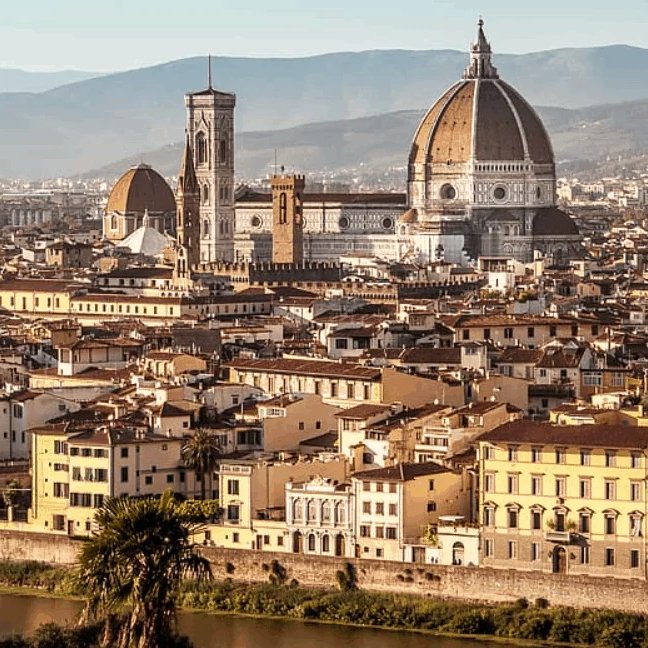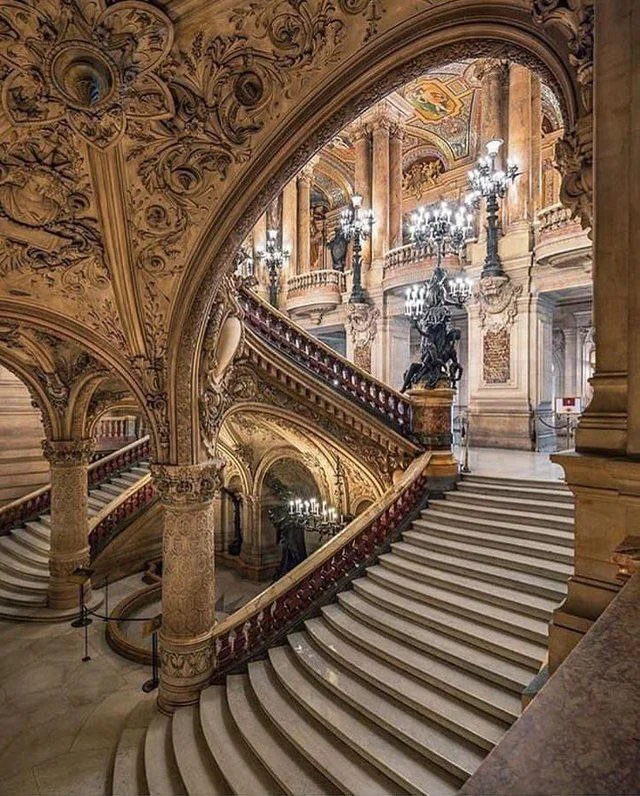Brunelleschi's Dome - they called it! It is a fascinating tale of persistence and brilliance!
The grand cathedral of Santa Maria del Fiore stands as a testament to the ingenuity and determination of one man, Filippo Brunelleschi. 🧵
The grand cathedral of Santa Maria del Fiore stands as a testament to the ingenuity and determination of one man, Filippo Brunelleschi. 🧵

Santa Maria del Fiore, a World Heritage site, boasts the largest masonry dome still standing today.
It is taller than the Statue of Liberty and weighs as much as a cruise ship.
Construction on the cathedral first started in 1296.
Despite the grandeur and ambition of the project, architects and builders faced an insurmountable challenge: how to construct a dome that would crown the massive structure.
For over a century, the challenge of constructing such a dome stumped some of the greatest minds in architecture.
It is taller than the Statue of Liberty and weighs as much as a cruise ship.
Construction on the cathedral first started in 1296.
Despite the grandeur and ambition of the project, architects and builders faced an insurmountable challenge: how to construct a dome that would crown the massive structure.
For over a century, the challenge of constructing such a dome stumped some of the greatest minds in architecture.

The cathedral’s design required a dome so large that no known method of construction could support its weight.
Traditional techniques involved the use of wooden scaffolding and supports, but given the vast dimensions of the dome, there wasn’t enough timber in Tuscany to build such a structure.
Many doubted if the dome could ever be built, and the incomplete cathedral became a symbol of frustration and stalled ambition.
Traditional techniques involved the use of wooden scaffolding and supports, but given the vast dimensions of the dome, there wasn’t enough timber in Tuscany to build such a structure.
Many doubted if the dome could ever be built, and the incomplete cathedral became a symbol of frustration and stalled ambition.

This is when Filippo Brunelleschi, a goldsmith and clockmaker, entered the picture. He had an insatiable curiosity for ancient engineering and architecture.
In the early 1400s, Brunelleschi was already known for his innovative thinking.
One of Brunelleschi's arch-nemesis was Lorenzo Ghiberti, a fellow goldsmith and sculptor.
In 1401, they competed to design new bronze doors for the Florence Baptistry, but when asked to collaborate after the jury couldn't decide between their entries, Brunelleschi refused and forfeited, subsequently shifting his focus to architecture and linear perspective.
In the early 1400s, Brunelleschi was already known for his innovative thinking.
One of Brunelleschi's arch-nemesis was Lorenzo Ghiberti, a fellow goldsmith and sculptor.
In 1401, they competed to design new bronze doors for the Florence Baptistry, but when asked to collaborate after the jury couldn't decide between their entries, Brunelleschi refused and forfeited, subsequently shifting his focus to architecture and linear perspective.

Brunelleschi's first architectural commission was the Ospedale degli Innocenti (1419–c. 1445), or known as Foundling Hospital, designed as a home for orphans. 

Soon after starting the Foundling Hospital, Brunelleschi undertook the Basilica of San Lorenzo, Florence's largest church and Medici family mausoleum, where he designed the central nave, collateral naves with small chapels, and the old sacristy, with later contributions from other architects, including Michelangelo.

When Florence's leaders announced a competition to find the best solution for the dome, Brunelleschi’s unorthodox ideas immediately caught their attention.
Confident yet secretive, he proposed a daring new approach that would forever change architecture.
Despite skepticism from his peers, Brunelleschi was given the green light to proceed.

Confident yet secretive, he proposed a daring new approach that would forever change architecture.
Despite skepticism from his peers, Brunelleschi was given the green light to proceed.


Brunelleschi's plan was revolutionary.
Instead of relying on a single wooden support structure, he envisioned a double-shell dome, an inner and outer layer connected by a series of ribs.
This design would distribute the weight evenly and allow the dome to support itself as it rose.
To further ensure stability, he planned to use a herringbone brick pattern that would interlock and distribute the weight outward.
Instead of relying on a single wooden support structure, he envisioned a double-shell dome, an inner and outer layer connected by a series of ribs.
This design would distribute the weight evenly and allow the dome to support itself as it rose.
To further ensure stability, he planned to use a herringbone brick pattern that would interlock and distribute the weight outward.

We still don't fully understand how he managed to prevent 4 million bricks from collapsing any moment.
However, what we do know is that the ancient Roman technique called opus spicatum, used in walls and hearths, does resemble the single loxodrome pattern employed by Brunelleschi in the Florentine duomo.
However, what we do know is that the ancient Roman technique called opus spicatum, used in walls and hearths, does resemble the single loxodrome pattern employed by Brunelleschi in the Florentine duomo.

Additionally, the Ardestan Friday Mosque in Isfahan, Iran, built around 1088 A.D. also showcases a double loxodrome technique. 

Recently, researchers from Princeton and the University of Bergamo have used computational methods to mathematically prove the structural physics behind this type of dome, revealing in a 2020 study how such domes were built self-supporting, without shoring or forms.
The double loxodrome is a structural technique where vertical bricks crisscross around the dome, interlocked by horizontal bricks to form plate-bandes, distributing the force throughout the dome, maintaining the shape and stability of the structure.
The double loxodrome is a structural technique where vertical bricks crisscross around the dome, interlocked by horizontal bricks to form plate-bandes, distributing the force throughout the dome, maintaining the shape and stability of the structure.

Brunelleschi began construction in 1420, meticulously overseeing every aspect of the project.
His innovative use of machinery and tools, such as the ox-hoist, allowed workers to lift heavy materials to great heights.
These machines were so advanced for their time that they were seen as almost magical, further cementing Brunelleschi's reputation as a genius.
His innovative use of machinery and tools, such as the ox-hoist, allowed workers to lift heavy materials to great heights.
These machines were so advanced for their time that they were seen as almost magical, further cementing Brunelleschi's reputation as a genius.

As the dome took shape, it became clear that Brunelleschi’s design was not only functional but also elegant.
The intricate brickwork and the soaring height of the dome were awe-inspiring. Day by day, brick by brick, the cathedral's dome grew, defying gravity and silencing the doubters.
In 1436, after sixteen years of relentless effort, the dome was finally completed.
It was an architectural marvel, standing 114 feet in diameter and soaring 375 feet above the ground.
The intricate brickwork and the soaring height of the dome were awe-inspiring. Day by day, brick by brick, the cathedral's dome grew, defying gravity and silencing the doubters.
In 1436, after sixteen years of relentless effort, the dome was finally completed.
It was an architectural marvel, standing 114 feet in diameter and soaring 375 feet above the ground.

Brunelleschi’s success was not just in the dome itself but in the new techniques and principles he introduced to the world of architecture.
Brunelleschi is credited with developing a precise system of linear perspective, revolutionizing painting by enabling artists to create accurate three-dimensional representations on two-dimensional surfaces, as seen in his experiments and subsequent influences on artists like Alberti, Piero della Francesca, and Leonardo da Vinci.
Brunelleschi is credited with developing a precise system of linear perspective, revolutionizing painting by enabling artists to create accurate three-dimensional representations on two-dimensional surfaces, as seen in his experiments and subsequent influences on artists like Alberti, Piero della Francesca, and Leonardo da Vinci.

In 1421, Brunelleschi received one of the first modern patents for his invention of a cost-effective river transport vessel for marble on the Arno, marking a significant moment in patent law and reflecting his effort to work independently of guild constraints. 

The completion of the cathedral also marked a turning point in the Renaissance, a period characterized by a resurgence of art, culture, and innovation.
St. Peter's Basilica in Rome, built by the Sangallo masters and consecrated in 1626, exhibits the double loxodrome technique, which was based on the Brunelleschi’s masterpiece.
St. Peter's Basilica in Rome, built by the Sangallo masters and consecrated in 1626, exhibits the double loxodrome technique, which was based on the Brunelleschi’s masterpiece.

In the annals of architectural history, Brunelleschi’s dome is a symbol of human potential and the transformative power of creativity.
It reminds us that if medieval thinkers could achieve great feats by thinking outside the box and taking risks others avoided, we should question what is stopping us from doing the same today.
It reminds us that if medieval thinkers could achieve great feats by thinking outside the box and taking risks others avoided, we should question what is stopping us from doing the same today.

This article was published in the premium version of our newsletter today - subscribe at:
thecultureexplorer.beehiiv.com/p/brunelleschi…
thecultureexplorer.beehiiv.com/p/brunelleschi…
• • •
Missing some Tweet in this thread? You can try to
force a refresh






















